Organization Theory: Exploring Modernist and Postmodern Theories
VerifiedAdded on 2022/09/01
|10
|2774
|20
Essay
AI Summary
This essay provides a comprehensive overview of organization theory, focusing on the contrasting perspectives of modernist and postmodernist approaches. It begins by defining organization theory as a system for managing labor and increasing service delivery, emphasizing its importance in decision-making and understanding organizational styles. The essay then delves into modernist theory, characterizing organizations as open systems that adapt to their environments and highlighting concepts like mechanistic structures, information perspectives, and ecological niches. It contrasts this with postmodern theory, which emphasizes the role of knowledge and power, examining concepts like de-differentiation, feminist organizations, and the impact of technology on organizational structure and culture. The essay further explores the implications of postmodern theory on stakeholder satisfaction, centralization, hierarchy, and the influence of technology on managerial control and organizational design, concluding with a synthesis of both theories' relevance to contemporary organizations.
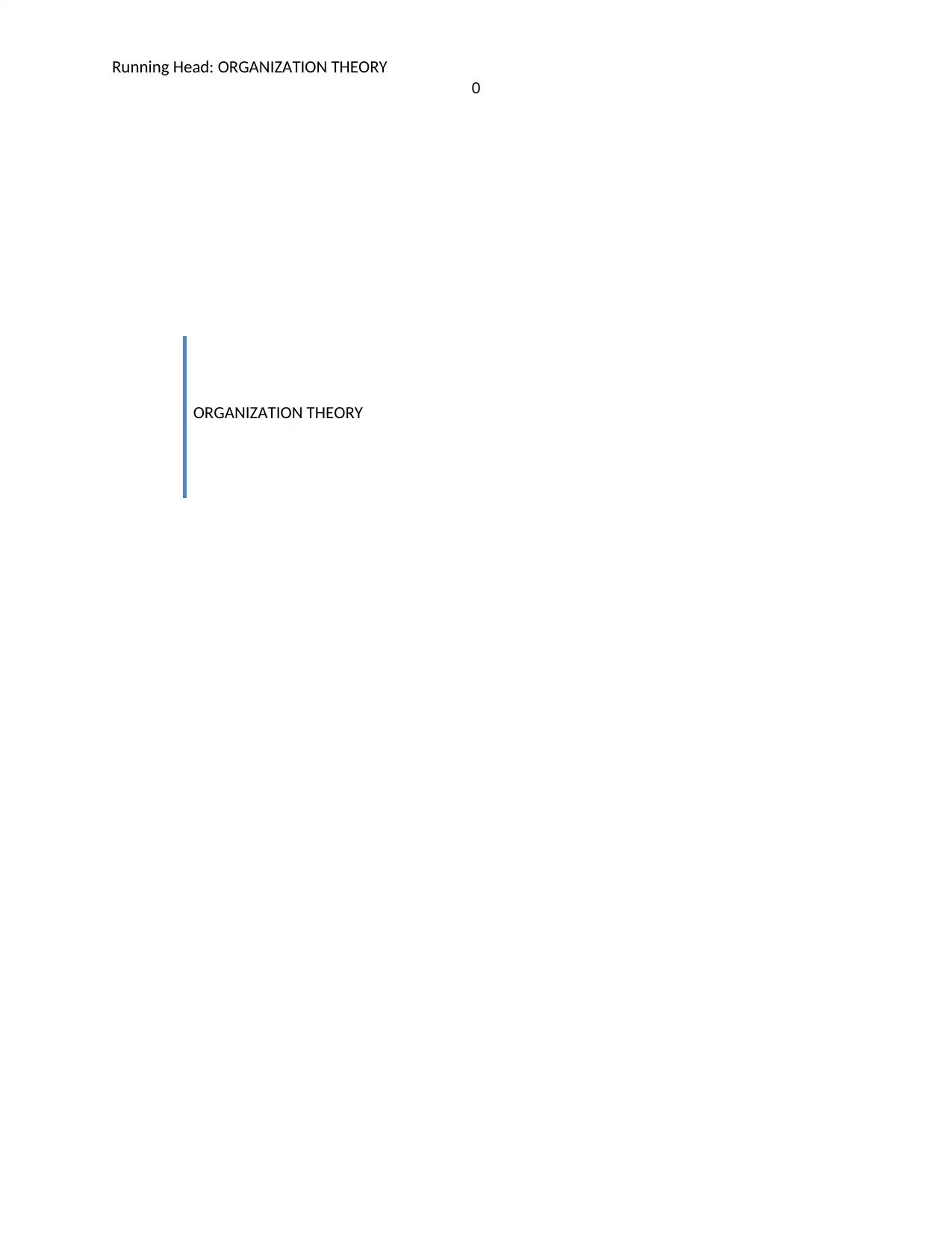
Running Head: ORGANIZATION THEORY
0
ORGANIZATION THEORY
0
ORGANIZATION THEORY
Paraphrase This Document
Need a fresh take? Get an instant paraphrase of this document with our AI Paraphraser
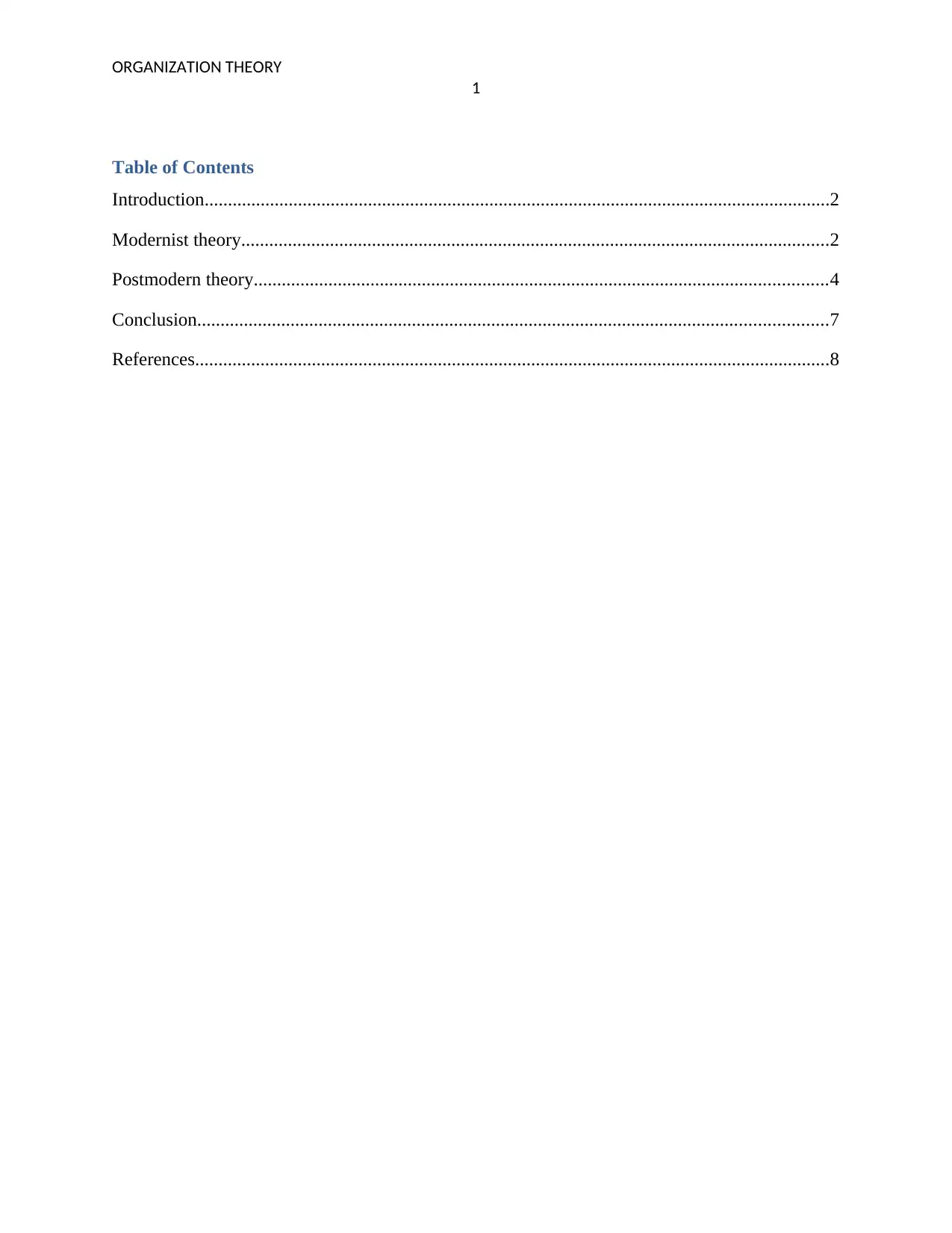
ORGANIZATION THEORY
1
Table of Contents
Introduction......................................................................................................................................2
Modernist theory..............................................................................................................................2
Postmodern theory...........................................................................................................................4
Conclusion.......................................................................................................................................7
References........................................................................................................................................8
1
Table of Contents
Introduction......................................................................................................................................2
Modernist theory..............................................................................................................................2
Postmodern theory...........................................................................................................................4
Conclusion.......................................................................................................................................7
References........................................................................................................................................8
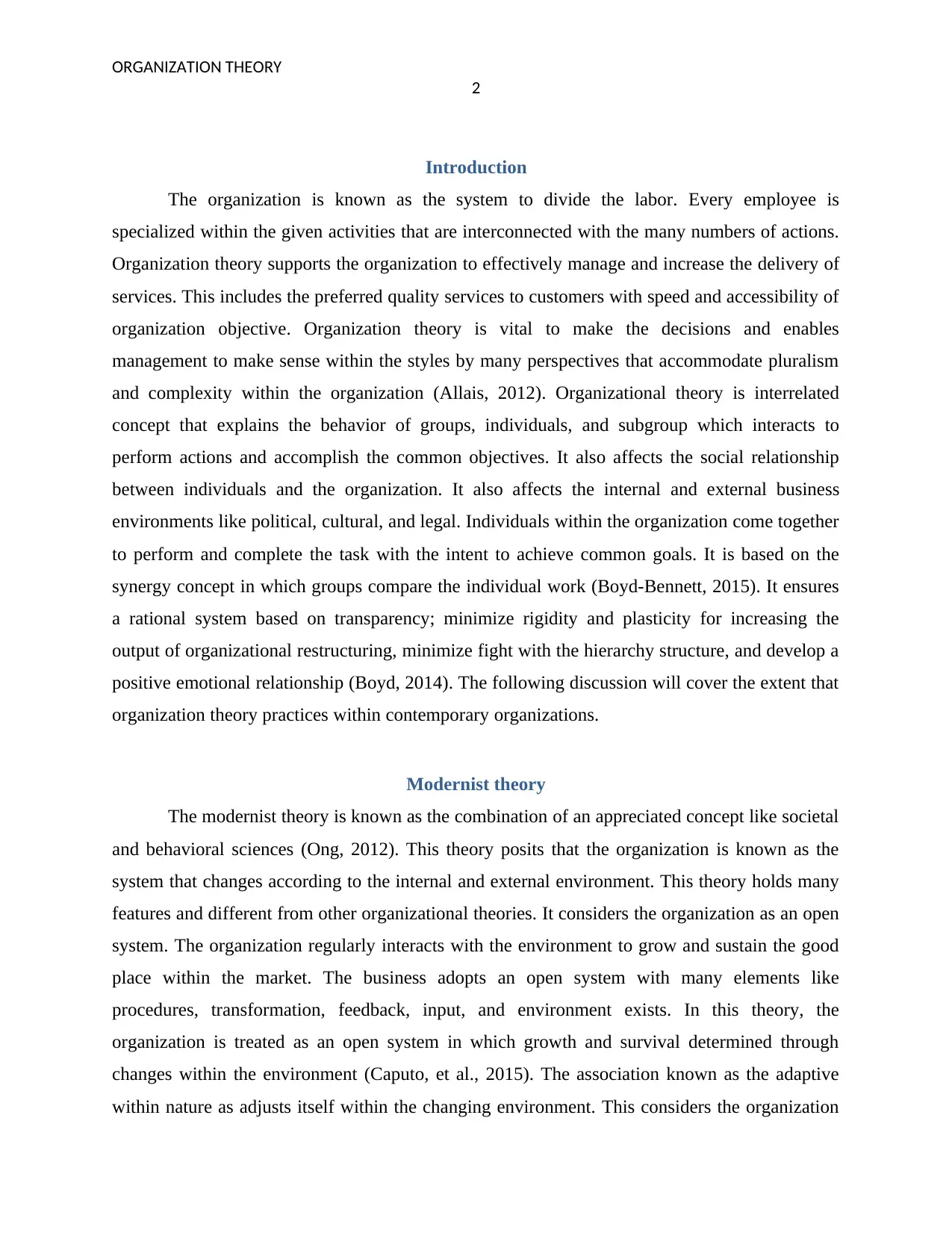
ORGANIZATION THEORY
2
Introduction
The organization is known as the system to divide the labor. Every employee is
specialized within the given activities that are interconnected with the many numbers of actions.
Organization theory supports the organization to effectively manage and increase the delivery of
services. This includes the preferred quality services to customers with speed and accessibility of
organization objective. Organization theory is vital to make the decisions and enables
management to make sense within the styles by many perspectives that accommodate pluralism
and complexity within the organization (Allais, 2012). Organizational theory is interrelated
concept that explains the behavior of groups, individuals, and subgroup which interacts to
perform actions and accomplish the common objectives. It also affects the social relationship
between individuals and the organization. It also affects the internal and external business
environments like political, cultural, and legal. Individuals within the organization come together
to perform and complete the task with the intent to achieve common goals. It is based on the
synergy concept in which groups compare the individual work (Boyd-Bennett, 2015). It ensures
a rational system based on transparency; minimize rigidity and plasticity for increasing the
output of organizational restructuring, minimize fight with the hierarchy structure, and develop a
positive emotional relationship (Boyd, 2014). The following discussion will cover the extent that
organization theory practices within contemporary organizations.
Modernist theory
The modernist theory is known as the combination of an appreciated concept like societal
and behavioral sciences (Ong, 2012). This theory posits that the organization is known as the
system that changes according to the internal and external environment. This theory holds many
features and different from other organizational theories. It considers the organization as an open
system. The organization regularly interacts with the environment to grow and sustain the good
place within the market. The business adopts an open system with many elements like
procedures, transformation, feedback, input, and environment exists. In this theory, the
organization is treated as an open system in which growth and survival determined through
changes within the environment (Caputo, et al., 2015). The association known as the adaptive
within nature as adjusts itself within the changing environment. This considers the organization
2
Introduction
The organization is known as the system to divide the labor. Every employee is
specialized within the given activities that are interconnected with the many numbers of actions.
Organization theory supports the organization to effectively manage and increase the delivery of
services. This includes the preferred quality services to customers with speed and accessibility of
organization objective. Organization theory is vital to make the decisions and enables
management to make sense within the styles by many perspectives that accommodate pluralism
and complexity within the organization (Allais, 2012). Organizational theory is interrelated
concept that explains the behavior of groups, individuals, and subgroup which interacts to
perform actions and accomplish the common objectives. It also affects the social relationship
between individuals and the organization. It also affects the internal and external business
environments like political, cultural, and legal. Individuals within the organization come together
to perform and complete the task with the intent to achieve common goals. It is based on the
synergy concept in which groups compare the individual work (Boyd-Bennett, 2015). It ensures
a rational system based on transparency; minimize rigidity and plasticity for increasing the
output of organizational restructuring, minimize fight with the hierarchy structure, and develop a
positive emotional relationship (Boyd, 2014). The following discussion will cover the extent that
organization theory practices within contemporary organizations.
Modernist theory
The modernist theory is known as the combination of an appreciated concept like societal
and behavioral sciences (Ong, 2012). This theory posits that the organization is known as the
system that changes according to the internal and external environment. This theory holds many
features and different from other organizational theories. It considers the organization as an open
system. The organization regularly interacts with the environment to grow and sustain the good
place within the market. The business adopts an open system with many elements like
procedures, transformation, feedback, input, and environment exists. In this theory, the
organization is treated as an open system in which growth and survival determined through
changes within the environment (Caputo, et al., 2015). The association known as the adaptive
within nature as adjusts itself within the changing environment. This considers the organization
⊘ This is a preview!⊘
Do you want full access?
Subscribe today to unlock all pages.

Trusted by 1+ million students worldwide
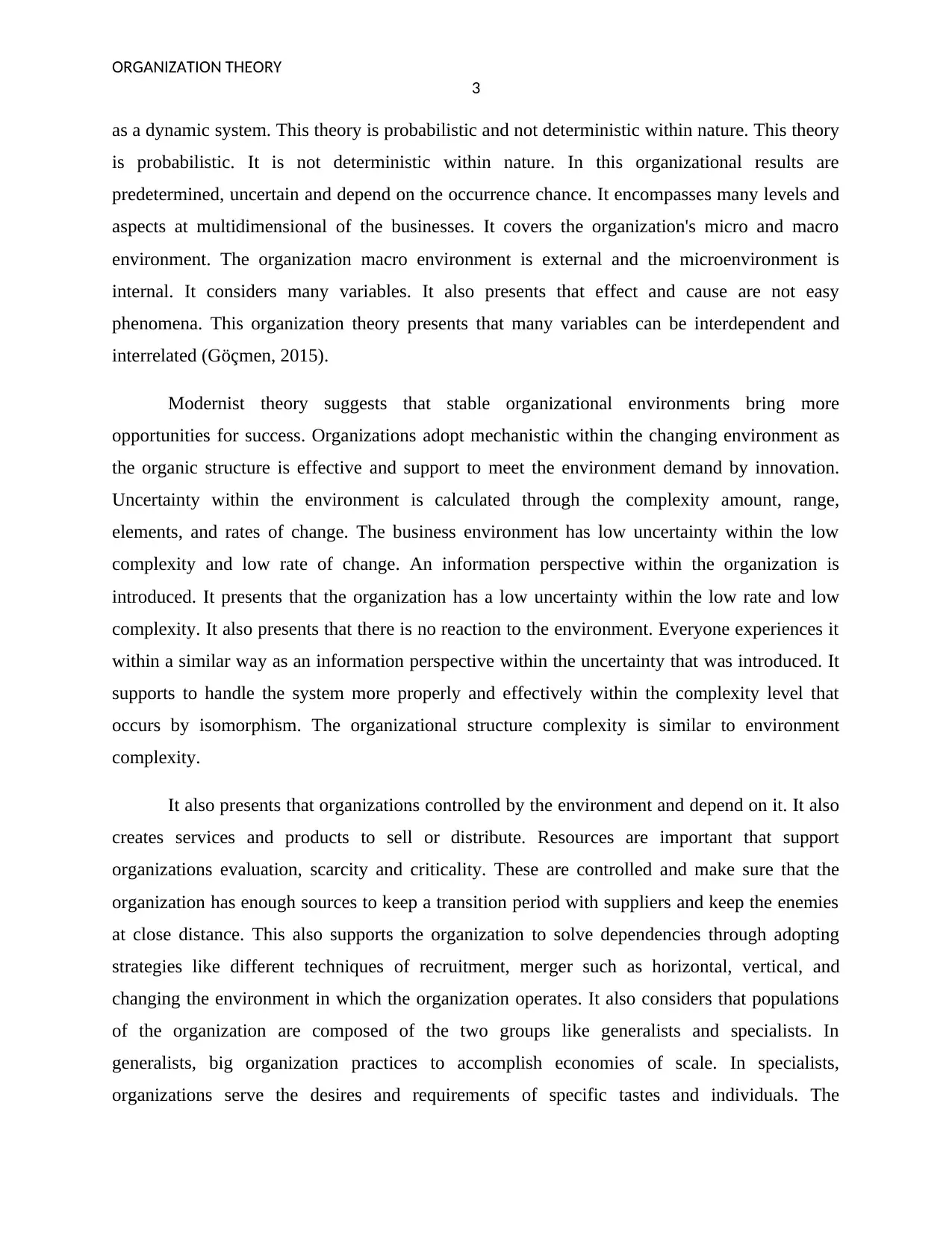
ORGANIZATION THEORY
3
as a dynamic system. This theory is probabilistic and not deterministic within nature. This theory
is probabilistic. It is not deterministic within nature. In this organizational results are
predetermined, uncertain and depend on the occurrence chance. It encompasses many levels and
aspects at multidimensional of the businesses. It covers the organization's micro and macro
environment. The organization macro environment is external and the microenvironment is
internal. It considers many variables. It also presents that effect and cause are not easy
phenomena. This organization theory presents that many variables can be interdependent and
interrelated (Göçmen, 2015).
Modernist theory suggests that stable organizational environments bring more
opportunities for success. Organizations adopt mechanistic within the changing environment as
the organic structure is effective and support to meet the environment demand by innovation.
Uncertainty within the environment is calculated through the complexity amount, range,
elements, and rates of change. The business environment has low uncertainty within the low
complexity and low rate of change. An information perspective within the organization is
introduced. It presents that the organization has a low uncertainty within the low rate and low
complexity. It also presents that there is no reaction to the environment. Everyone experiences it
within a similar way as an information perspective within the uncertainty that was introduced. It
supports to handle the system more properly and effectively within the complexity level that
occurs by isomorphism. The organizational structure complexity is similar to environment
complexity.
It also presents that organizations controlled by the environment and depend on it. It also
creates services and products to sell or distribute. Resources are important that support
organizations evaluation, scarcity and criticality. These are controlled and make sure that the
organization has enough sources to keep a transition period with suppliers and keep the enemies
at close distance. This also supports the organization to solve dependencies through adopting
strategies like different techniques of recruitment, merger such as horizontal, vertical, and
changing the environment in which the organization operates. It also considers that populations
of the organization are composed of the two groups like generalists and specialists. In
generalists, big organization practices to accomplish economies of scale. In specialists,
organizations serve the desires and requirements of specific tastes and individuals. The
3
as a dynamic system. This theory is probabilistic and not deterministic within nature. This theory
is probabilistic. It is not deterministic within nature. In this organizational results are
predetermined, uncertain and depend on the occurrence chance. It encompasses many levels and
aspects at multidimensional of the businesses. It covers the organization's micro and macro
environment. The organization macro environment is external and the microenvironment is
internal. It considers many variables. It also presents that effect and cause are not easy
phenomena. This organization theory presents that many variables can be interdependent and
interrelated (Göçmen, 2015).
Modernist theory suggests that stable organizational environments bring more
opportunities for success. Organizations adopt mechanistic within the changing environment as
the organic structure is effective and support to meet the environment demand by innovation.
Uncertainty within the environment is calculated through the complexity amount, range,
elements, and rates of change. The business environment has low uncertainty within the low
complexity and low rate of change. An information perspective within the organization is
introduced. It presents that the organization has a low uncertainty within the low rate and low
complexity. It also presents that there is no reaction to the environment. Everyone experiences it
within a similar way as an information perspective within the uncertainty that was introduced. It
supports to handle the system more properly and effectively within the complexity level that
occurs by isomorphism. The organizational structure complexity is similar to environment
complexity.
It also presents that organizations controlled by the environment and depend on it. It also
creates services and products to sell or distribute. Resources are important that support
organizations evaluation, scarcity and criticality. These are controlled and make sure that the
organization has enough sources to keep a transition period with suppliers and keep the enemies
at close distance. This also supports the organization to solve dependencies through adopting
strategies like different techniques of recruitment, merger such as horizontal, vertical, and
changing the environment in which the organization operates. It also considers that populations
of the organization are composed of the two groups like generalists and specialists. In
generalists, big organization practices to accomplish economies of scale. In specialists,
organizations serve the desires and requirements of specific tastes and individuals. The
Paraphrase This Document
Need a fresh take? Get an instant paraphrase of this document with our AI Paraphraser
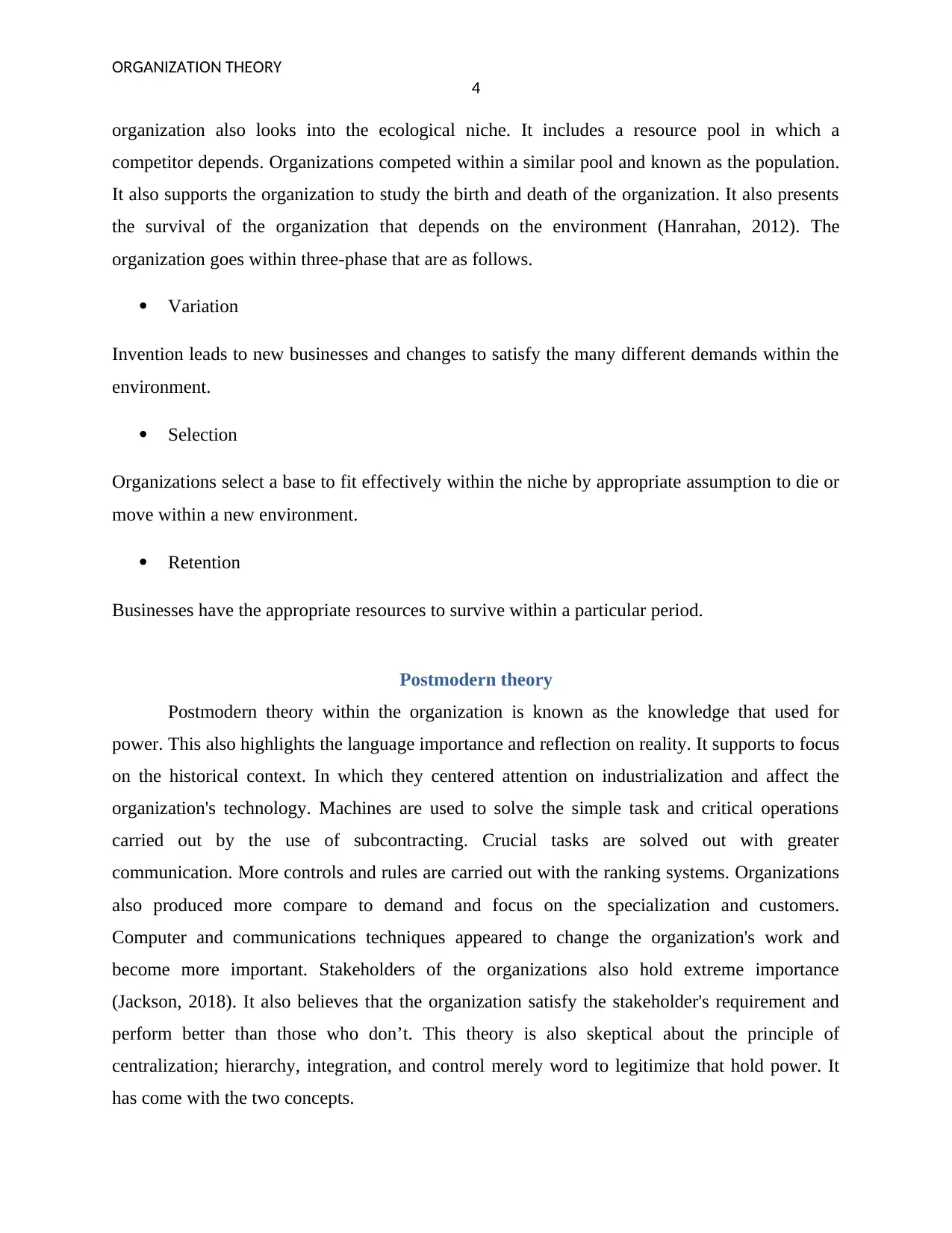
ORGANIZATION THEORY
4
organization also looks into the ecological niche. It includes a resource pool in which a
competitor depends. Organizations competed within a similar pool and known as the population.
It also supports the organization to study the birth and death of the organization. It also presents
the survival of the organization that depends on the environment (Hanrahan, 2012). The
organization goes within three-phase that are as follows.
Variation
Invention leads to new businesses and changes to satisfy the many different demands within the
environment.
Selection
Organizations select a base to fit effectively within the niche by appropriate assumption to die or
move within a new environment.
Retention
Businesses have the appropriate resources to survive within a particular period.
Postmodern theory
Postmodern theory within the organization is known as the knowledge that used for
power. This also highlights the language importance and reflection on reality. It supports to focus
on the historical context. In which they centered attention on industrialization and affect the
organization's technology. Machines are used to solve the simple task and critical operations
carried out by the use of subcontracting. Crucial tasks are solved out with greater
communication. More controls and rules are carried out with the ranking systems. Organizations
also produced more compare to demand and focus on the specialization and customers.
Computer and communications techniques appeared to change the organization's work and
become more important. Stakeholders of the organizations also hold extreme importance
(Jackson, 2018). It also believes that the organization satisfy the stakeholder's requirement and
perform better than those who don’t. This theory is also skeptical about the principle of
centralization; hierarchy, integration, and control merely word to legitimize that hold power. It
has come with the two concepts.
4
organization also looks into the ecological niche. It includes a resource pool in which a
competitor depends. Organizations competed within a similar pool and known as the population.
It also supports the organization to study the birth and death of the organization. It also presents
the survival of the organization that depends on the environment (Hanrahan, 2012). The
organization goes within three-phase that are as follows.
Variation
Invention leads to new businesses and changes to satisfy the many different demands within the
environment.
Selection
Organizations select a base to fit effectively within the niche by appropriate assumption to die or
move within a new environment.
Retention
Businesses have the appropriate resources to survive within a particular period.
Postmodern theory
Postmodern theory within the organization is known as the knowledge that used for
power. This also highlights the language importance and reflection on reality. It supports to focus
on the historical context. In which they centered attention on industrialization and affect the
organization's technology. Machines are used to solve the simple task and critical operations
carried out by the use of subcontracting. Crucial tasks are solved out with greater
communication. More controls and rules are carried out with the ranking systems. Organizations
also produced more compare to demand and focus on the specialization and customers.
Computer and communications techniques appeared to change the organization's work and
become more important. Stakeholders of the organizations also hold extreme importance
(Jackson, 2018). It also believes that the organization satisfy the stakeholder's requirement and
perform better than those who don’t. This theory is also skeptical about the principle of
centralization; hierarchy, integration, and control merely word to legitimize that hold power. It
has come with the two concepts.
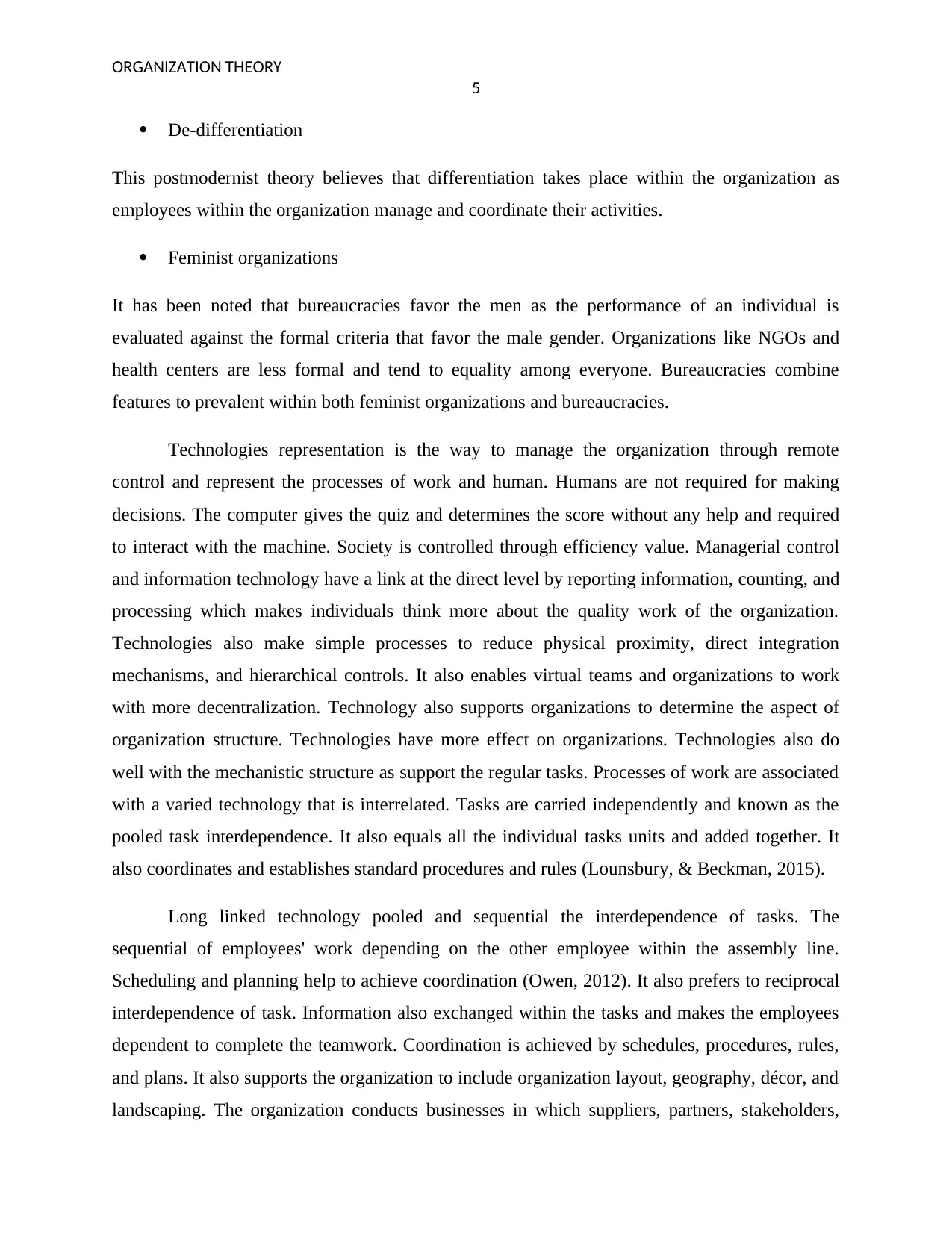
ORGANIZATION THEORY
5
De-differentiation
This postmodernist theory believes that differentiation takes place within the organization as
employees within the organization manage and coordinate their activities.
Feminist organizations
It has been noted that bureaucracies favor the men as the performance of an individual is
evaluated against the formal criteria that favor the male gender. Organizations like NGOs and
health centers are less formal and tend to equality among everyone. Bureaucracies combine
features to prevalent within both feminist organizations and bureaucracies.
Technologies representation is the way to manage the organization through remote
control and represent the processes of work and human. Humans are not required for making
decisions. The computer gives the quiz and determines the score without any help and required
to interact with the machine. Society is controlled through efficiency value. Managerial control
and information technology have a link at the direct level by reporting information, counting, and
processing which makes individuals think more about the quality work of the organization.
Technologies also make simple processes to reduce physical proximity, direct integration
mechanisms, and hierarchical controls. It also enables virtual teams and organizations to work
with more decentralization. Technology also supports organizations to determine the aspect of
organization structure. Technologies have more effect on organizations. Technologies also do
well with the mechanistic structure as support the regular tasks. Processes of work are associated
with a varied technology that is interrelated. Tasks are carried independently and known as the
pooled task interdependence. It also equals all the individual tasks units and added together. It
also coordinates and establishes standard procedures and rules (Lounsbury, & Beckman, 2015).
Long linked technology pooled and sequential the interdependence of tasks. The
sequential of employees' work depending on the other employee within the assembly line.
Scheduling and planning help to achieve coordination (Owen, 2012). It also prefers to reciprocal
interdependence of task. Information also exchanged within the tasks and makes the employees
dependent to complete the teamwork. Coordination is achieved by schedules, procedures, rules,
and plans. It also supports the organization to include organization layout, geography, décor, and
landscaping. The organization conducts businesses in which suppliers, partners, stakeholders,
5
De-differentiation
This postmodernist theory believes that differentiation takes place within the organization as
employees within the organization manage and coordinate their activities.
Feminist organizations
It has been noted that bureaucracies favor the men as the performance of an individual is
evaluated against the formal criteria that favor the male gender. Organizations like NGOs and
health centers are less formal and tend to equality among everyone. Bureaucracies combine
features to prevalent within both feminist organizations and bureaucracies.
Technologies representation is the way to manage the organization through remote
control and represent the processes of work and human. Humans are not required for making
decisions. The computer gives the quiz and determines the score without any help and required
to interact with the machine. Society is controlled through efficiency value. Managerial control
and information technology have a link at the direct level by reporting information, counting, and
processing which makes individuals think more about the quality work of the organization.
Technologies also make simple processes to reduce physical proximity, direct integration
mechanisms, and hierarchical controls. It also enables virtual teams and organizations to work
with more decentralization. Technology also supports organizations to determine the aspect of
organization structure. Technologies have more effect on organizations. Technologies also do
well with the mechanistic structure as support the regular tasks. Processes of work are associated
with a varied technology that is interrelated. Tasks are carried independently and known as the
pooled task interdependence. It also equals all the individual tasks units and added together. It
also coordinates and establishes standard procedures and rules (Lounsbury, & Beckman, 2015).
Long linked technology pooled and sequential the interdependence of tasks. The
sequential of employees' work depending on the other employee within the assembly line.
Scheduling and planning help to achieve coordination (Owen, 2012). It also prefers to reciprocal
interdependence of task. Information also exchanged within the tasks and makes the employees
dependent to complete the teamwork. Coordination is achieved by schedules, procedures, rules,
and plans. It also supports the organization to include organization layout, geography, décor, and
landscaping. The organization conducts businesses in which suppliers, partners, stakeholders,
⊘ This is a preview!⊘
Do you want full access?
Subscribe today to unlock all pages.

Trusted by 1+ million students worldwide
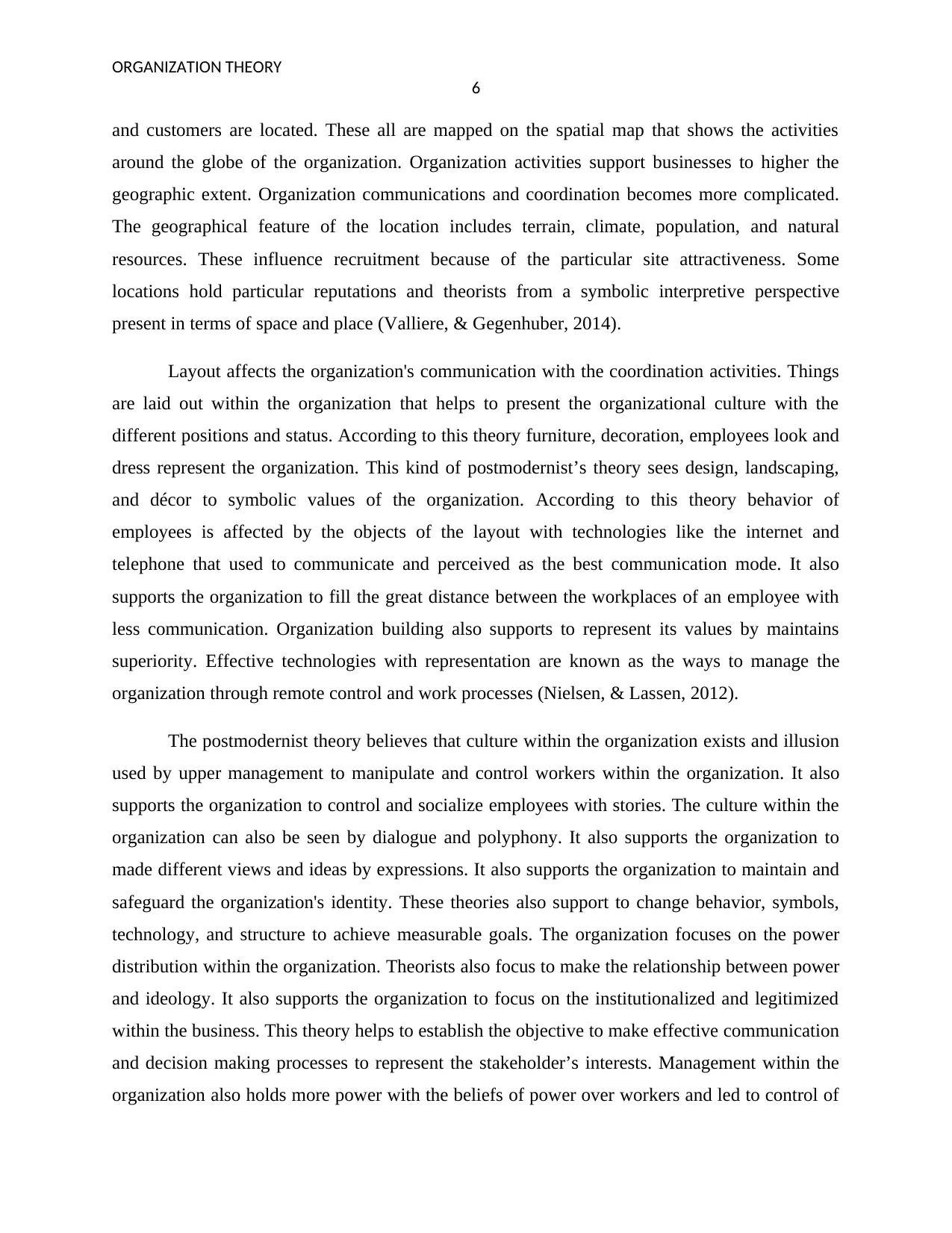
ORGANIZATION THEORY
6
and customers are located. These all are mapped on the spatial map that shows the activities
around the globe of the organization. Organization activities support businesses to higher the
geographic extent. Organization communications and coordination becomes more complicated.
The geographical feature of the location includes terrain, climate, population, and natural
resources. These influence recruitment because of the particular site attractiveness. Some
locations hold particular reputations and theorists from a symbolic interpretive perspective
present in terms of space and place (Valliere, & Gegenhuber, 2014).
Layout affects the organization's communication with the coordination activities. Things
are laid out within the organization that helps to present the organizational culture with the
different positions and status. According to this theory furniture, decoration, employees look and
dress represent the organization. This kind of postmodernist’s theory sees design, landscaping,
and décor to symbolic values of the organization. According to this theory behavior of
employees is affected by the objects of the layout with technologies like the internet and
telephone that used to communicate and perceived as the best communication mode. It also
supports the organization to fill the great distance between the workplaces of an employee with
less communication. Organization building also supports to represent its values by maintains
superiority. Effective technologies with representation are known as the ways to manage the
organization through remote control and work processes (Nielsen, & Lassen, 2012).
The postmodernist theory believes that culture within the organization exists and illusion
used by upper management to manipulate and control workers within the organization. It also
supports the organization to control and socialize employees with stories. The culture within the
organization can also be seen by dialogue and polyphony. It also supports the organization to
made different views and ideas by expressions. It also supports the organization to maintain and
safeguard the organization's identity. These theories also support to change behavior, symbols,
technology, and structure to achieve measurable goals. The organization focuses on the power
distribution within the organization. Theorists also focus to make the relationship between power
and ideology. It also supports the organization to focus on the institutionalized and legitimized
within the business. This theory helps to establish the objective to make effective communication
and decision making processes to represent the stakeholder’s interests. Management within the
organization also holds more power with the beliefs of power over workers and led to control of
6
and customers are located. These all are mapped on the spatial map that shows the activities
around the globe of the organization. Organization activities support businesses to higher the
geographic extent. Organization communications and coordination becomes more complicated.
The geographical feature of the location includes terrain, climate, population, and natural
resources. These influence recruitment because of the particular site attractiveness. Some
locations hold particular reputations and theorists from a symbolic interpretive perspective
present in terms of space and place (Valliere, & Gegenhuber, 2014).
Layout affects the organization's communication with the coordination activities. Things
are laid out within the organization that helps to present the organizational culture with the
different positions and status. According to this theory furniture, decoration, employees look and
dress represent the organization. This kind of postmodernist’s theory sees design, landscaping,
and décor to symbolic values of the organization. According to this theory behavior of
employees is affected by the objects of the layout with technologies like the internet and
telephone that used to communicate and perceived as the best communication mode. It also
supports the organization to fill the great distance between the workplaces of an employee with
less communication. Organization building also supports to represent its values by maintains
superiority. Effective technologies with representation are known as the ways to manage the
organization through remote control and work processes (Nielsen, & Lassen, 2012).
The postmodernist theory believes that culture within the organization exists and illusion
used by upper management to manipulate and control workers within the organization. It also
supports the organization to control and socialize employees with stories. The culture within the
organization can also be seen by dialogue and polyphony. It also supports the organization to
made different views and ideas by expressions. It also supports the organization to maintain and
safeguard the organization's identity. These theories also support to change behavior, symbols,
technology, and structure to achieve measurable goals. The organization focuses on the power
distribution within the organization. Theorists also focus to make the relationship between power
and ideology. It also supports the organization to focus on the institutionalized and legitimized
within the business. This theory helps to establish the objective to make effective communication
and decision making processes to represent the stakeholder’s interests. Management within the
organization also holds more power with the beliefs of power over workers and led to control of
Paraphrase This Document
Need a fresh take? Get an instant paraphrase of this document with our AI Paraphraser
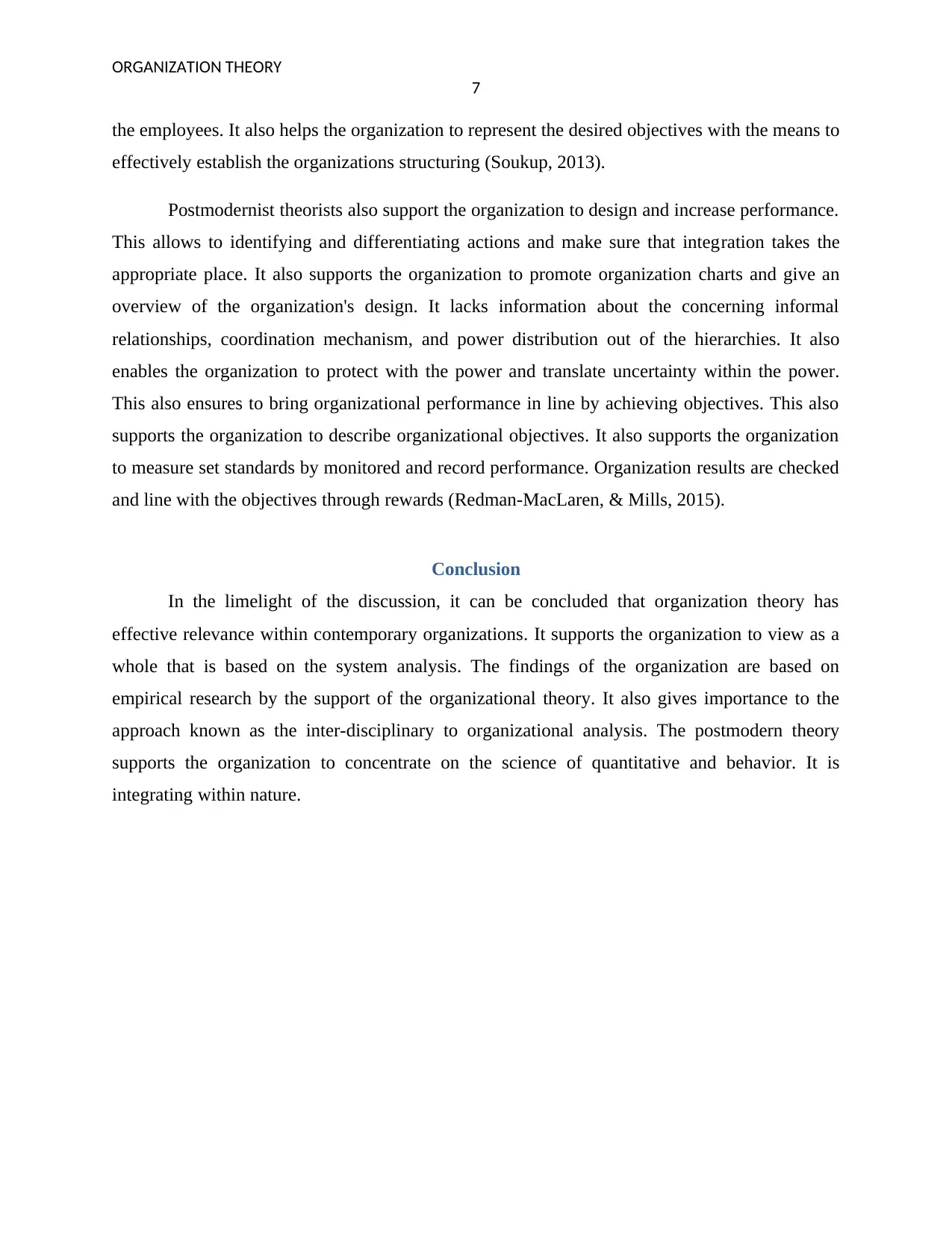
ORGANIZATION THEORY
7
the employees. It also helps the organization to represent the desired objectives with the means to
effectively establish the organizations structuring (Soukup, 2013).
Postmodernist theorists also support the organization to design and increase performance.
This allows to identifying and differentiating actions and make sure that integration takes the
appropriate place. It also supports the organization to promote organization charts and give an
overview of the organization's design. It lacks information about the concerning informal
relationships, coordination mechanism, and power distribution out of the hierarchies. It also
enables the organization to protect with the power and translate uncertainty within the power.
This also ensures to bring organizational performance in line by achieving objectives. This also
supports the organization to describe organizational objectives. It also supports the organization
to measure set standards by monitored and record performance. Organization results are checked
and line with the objectives through rewards (Redman-MacLaren, & Mills, 2015).
Conclusion
In the limelight of the discussion, it can be concluded that organization theory has
effective relevance within contemporary organizations. It supports the organization to view as a
whole that is based on the system analysis. The findings of the organization are based on
empirical research by the support of the organizational theory. It also gives importance to the
approach known as the inter-disciplinary to organizational analysis. The postmodern theory
supports the organization to concentrate on the science of quantitative and behavior. It is
integrating within nature.
7
the employees. It also helps the organization to represent the desired objectives with the means to
effectively establish the organizations structuring (Soukup, 2013).
Postmodernist theorists also support the organization to design and increase performance.
This allows to identifying and differentiating actions and make sure that integration takes the
appropriate place. It also supports the organization to promote organization charts and give an
overview of the organization's design. It lacks information about the concerning informal
relationships, coordination mechanism, and power distribution out of the hierarchies. It also
enables the organization to protect with the power and translate uncertainty within the power.
This also ensures to bring organizational performance in line by achieving objectives. This also
supports the organization to describe organizational objectives. It also supports the organization
to measure set standards by monitored and record performance. Organization results are checked
and line with the objectives through rewards (Redman-MacLaren, & Mills, 2015).
Conclusion
In the limelight of the discussion, it can be concluded that organization theory has
effective relevance within contemporary organizations. It supports the organization to view as a
whole that is based on the system analysis. The findings of the organization are based on
empirical research by the support of the organizational theory. It also gives importance to the
approach known as the inter-disciplinary to organizational analysis. The postmodern theory
supports the organization to concentrate on the science of quantitative and behavior. It is
integrating within nature.
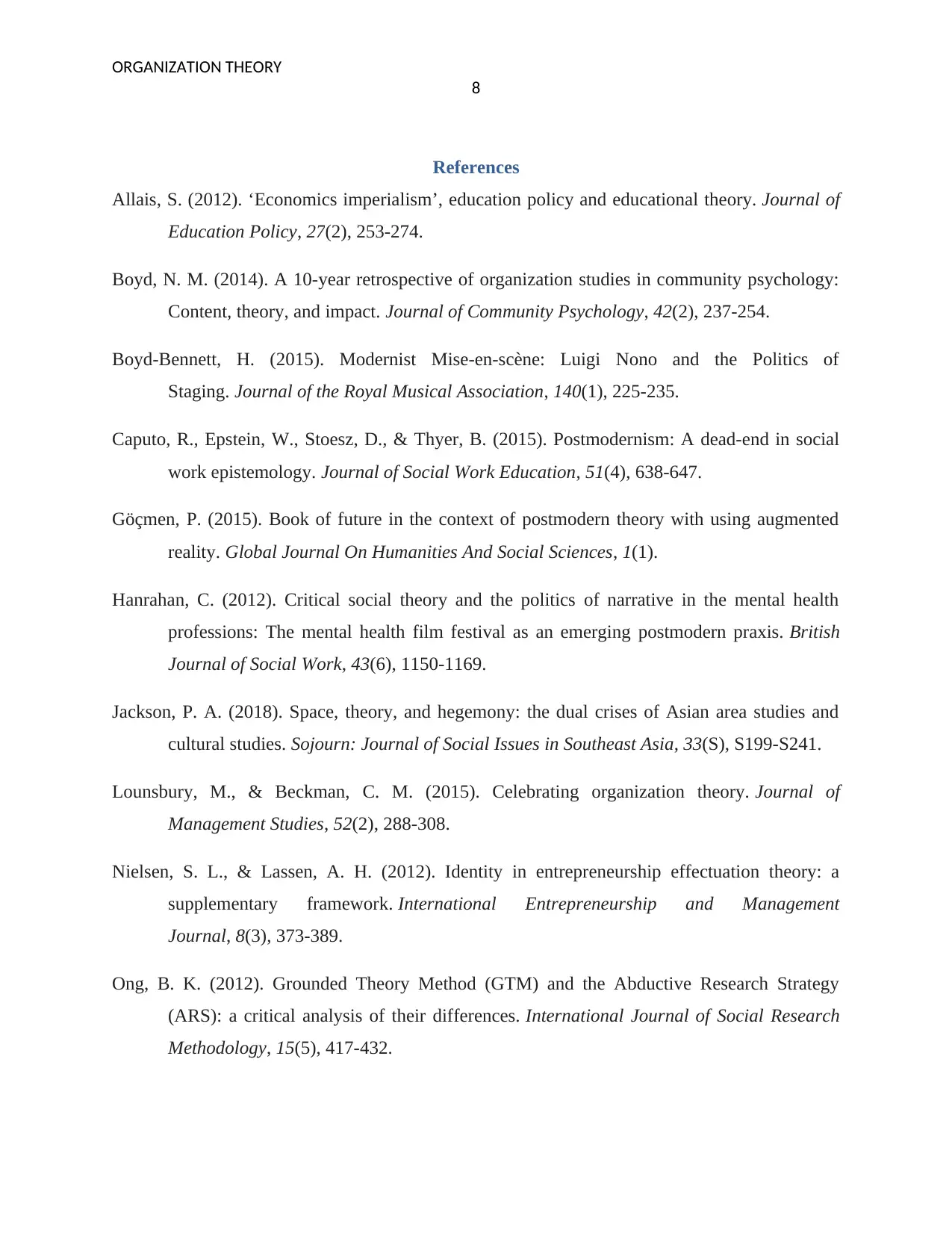
ORGANIZATION THEORY
8
References
Allais, S. (2012). ‘Economics imperialism’, education policy and educational theory. Journal of
Education Policy, 27(2), 253-274.
Boyd, N. M. (2014). A 10‐year retrospective of organization studies in community psychology:
Content, theory, and impact. Journal of Community Psychology, 42(2), 237-254.
Boyd-Bennett, H. (2015). Modernist Mise-en-scène: Luigi Nono and the Politics of
Staging. Journal of the Royal Musical Association, 140(1), 225-235.
Caputo, R., Epstein, W., Stoesz, D., & Thyer, B. (2015). Postmodernism: A dead-end in social
work epistemology. Journal of Social Work Education, 51(4), 638-647.
Göçmen, P. (2015). Book of future in the context of postmodern theory with using augmented
reality. Global Journal On Humanities And Social Sciences, 1(1).
Hanrahan, C. (2012). Critical social theory and the politics of narrative in the mental health
professions: The mental health film festival as an emerging postmodern praxis. British
Journal of Social Work, 43(6), 1150-1169.
Jackson, P. A. (2018). Space, theory, and hegemony: the dual crises of Asian area studies and
cultural studies. Sojourn: Journal of Social Issues in Southeast Asia, 33(S), S199-S241.
Lounsbury, M., & Beckman, C. M. (2015). Celebrating organization theory. Journal of
Management Studies, 52(2), 288-308.
Nielsen, S. L., & Lassen, A. H. (2012). Identity in entrepreneurship effectuation theory: a
supplementary framework. International Entrepreneurship and Management
Journal, 8(3), 373-389.
Ong, B. K. (2012). Grounded Theory Method (GTM) and the Abductive Research Strategy
(ARS): a critical analysis of their differences. International Journal of Social Research
Methodology, 15(5), 417-432.
8
References
Allais, S. (2012). ‘Economics imperialism’, education policy and educational theory. Journal of
Education Policy, 27(2), 253-274.
Boyd, N. M. (2014). A 10‐year retrospective of organization studies in community psychology:
Content, theory, and impact. Journal of Community Psychology, 42(2), 237-254.
Boyd-Bennett, H. (2015). Modernist Mise-en-scène: Luigi Nono and the Politics of
Staging. Journal of the Royal Musical Association, 140(1), 225-235.
Caputo, R., Epstein, W., Stoesz, D., & Thyer, B. (2015). Postmodernism: A dead-end in social
work epistemology. Journal of Social Work Education, 51(4), 638-647.
Göçmen, P. (2015). Book of future in the context of postmodern theory with using augmented
reality. Global Journal On Humanities And Social Sciences, 1(1).
Hanrahan, C. (2012). Critical social theory and the politics of narrative in the mental health
professions: The mental health film festival as an emerging postmodern praxis. British
Journal of Social Work, 43(6), 1150-1169.
Jackson, P. A. (2018). Space, theory, and hegemony: the dual crises of Asian area studies and
cultural studies. Sojourn: Journal of Social Issues in Southeast Asia, 33(S), S199-S241.
Lounsbury, M., & Beckman, C. M. (2015). Celebrating organization theory. Journal of
Management Studies, 52(2), 288-308.
Nielsen, S. L., & Lassen, A. H. (2012). Identity in entrepreneurship effectuation theory: a
supplementary framework. International Entrepreneurship and Management
Journal, 8(3), 373-389.
Ong, B. K. (2012). Grounded Theory Method (GTM) and the Abductive Research Strategy
(ARS): a critical analysis of their differences. International Journal of Social Research
Methodology, 15(5), 417-432.
⊘ This is a preview!⊘
Do you want full access?
Subscribe today to unlock all pages.

Trusted by 1+ million students worldwide
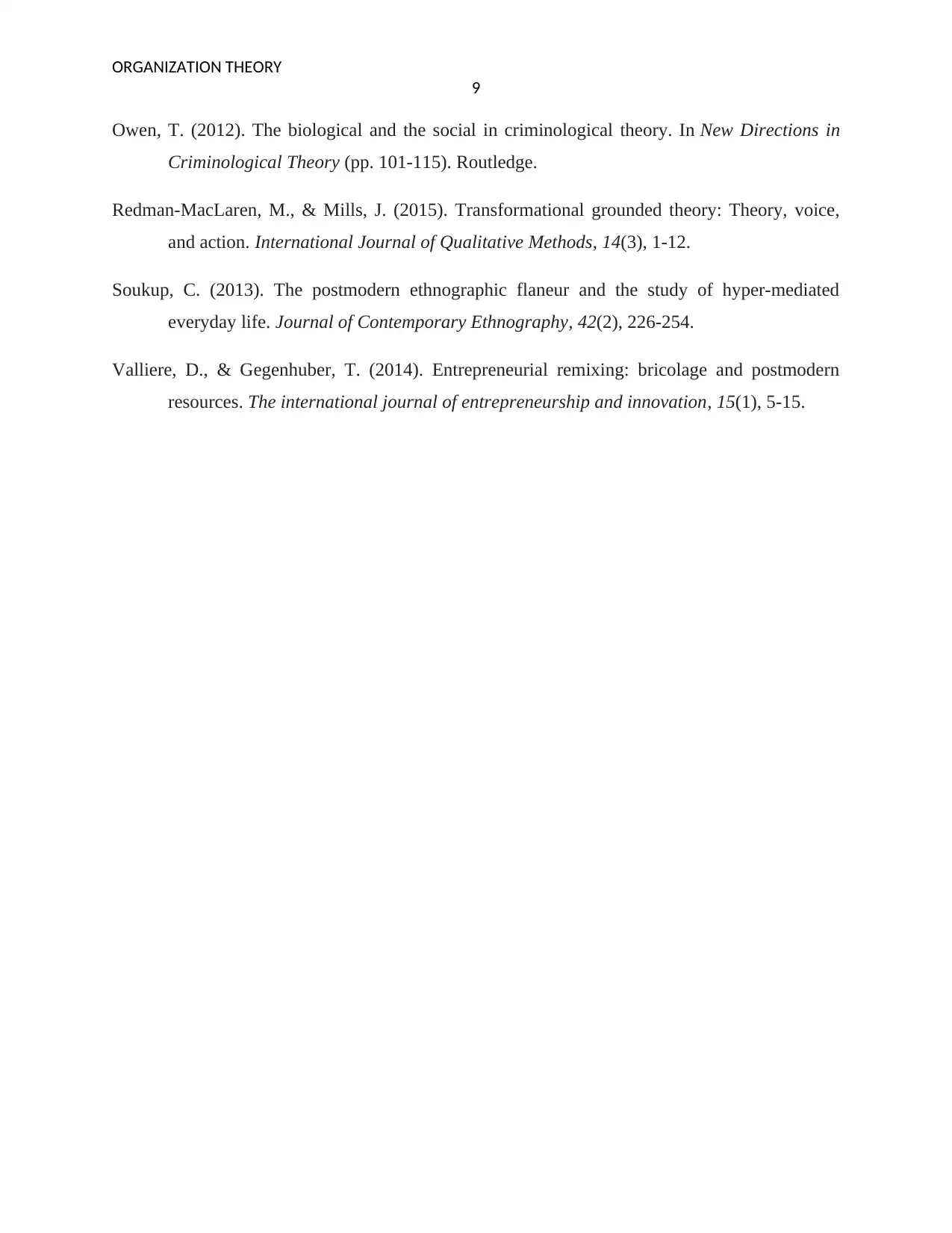
ORGANIZATION THEORY
9
Owen, T. (2012). The biological and the social in criminological theory. In New Directions in
Criminological Theory (pp. 101-115). Routledge.
Redman-MacLaren, M., & Mills, J. (2015). Transformational grounded theory: Theory, voice,
and action. International Journal of Qualitative Methods, 14(3), 1-12.
Soukup, C. (2013). The postmodern ethnographic flaneur and the study of hyper-mediated
everyday life. Journal of Contemporary Ethnography, 42(2), 226-254.
Valliere, D., & Gegenhuber, T. (2014). Entrepreneurial remixing: bricolage and postmodern
resources. The international journal of entrepreneurship and innovation, 15(1), 5-15.
9
Owen, T. (2012). The biological and the social in criminological theory. In New Directions in
Criminological Theory (pp. 101-115). Routledge.
Redman-MacLaren, M., & Mills, J. (2015). Transformational grounded theory: Theory, voice,
and action. International Journal of Qualitative Methods, 14(3), 1-12.
Soukup, C. (2013). The postmodern ethnographic flaneur and the study of hyper-mediated
everyday life. Journal of Contemporary Ethnography, 42(2), 226-254.
Valliere, D., & Gegenhuber, T. (2014). Entrepreneurial remixing: bricolage and postmodern
resources. The international journal of entrepreneurship and innovation, 15(1), 5-15.
1 out of 10
Related Documents
Your All-in-One AI-Powered Toolkit for Academic Success.
+13062052269
info@desklib.com
Available 24*7 on WhatsApp / Email
![[object Object]](/_next/static/media/star-bottom.7253800d.svg)
Unlock your academic potential
Copyright © 2020–2025 A2Z Services. All Rights Reserved. Developed and managed by ZUCOL.





